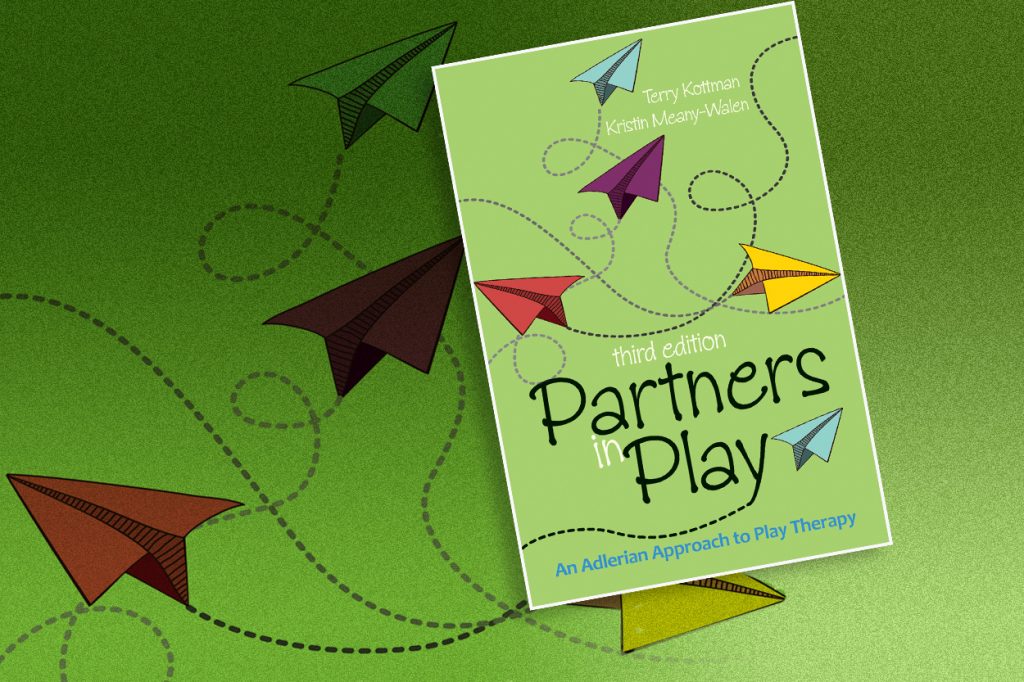It’s often said that play therapy reaches young clients through their own natural “language” of play. When combined with tenets of the Adlerian method, play therapy becomes a tool for the therapist to build an egalitarian relationship with the client while focusing on the individual and  his or her dynamics with others, according to Terry Kottman and Kristin Meany-Walen, co-authors of Partners in Play: An Adlerian Approach to Play Therapy.
his or her dynamics with others, according to Terry Kottman and Kristin Meany-Walen, co-authors of Partners in Play: An Adlerian Approach to Play Therapy.
“The Adlerian belief in the ability to make new choices and to reinterpret situations provides a vehicle for play therapists to work with children to get out of their boxes, change their lifestyle patterns, increase their social interest, make shifts in the goals of their behavior and a host of other forums for determining their paths,” write Meany-Walen and Kottman in the book’s second chapter. “One of your primary responsibilities as an Adlerian play therapist is to discover how each child expresses his or her special and wonderful self and to convey a sense of celebration in his or her uniqueness to the child, parents and other people who interact with him or her. Sometimes the child expresses uniqueness in a way that others do not appreciate.”
Meany-Walen, an assistant professor of counseling at the University of Northern Iowa, and Kottman, who runs a play therapy counseling, training and workshop center in Cedar Falls, Iowa, are both licensed mental health counselors and registered play therapists.
The third edition of Partners in Play was published earlier this year by the American Counseling Association.
Q+A: CT Online contacted Kottman and Meany-Walen recently to learn more about this unique approach. Their responses are co-written, except where noted.
Your book focuses on Adlerian play therapy, which combines play therapy techniques with the Adlerian method. Why do you think they are a good fit? Why does that combination work to help young clients?
Adlerian psychology has a clear and easy-to-follow way to conceptualize clients and figure out what is “underneath” the presenting problem. Before the development of Adlerian play therapy, there was no precedent for working with individual child clients, nor was there a precedent for using play as a treatment modality using Adlerian psychology. We believe that combining Adlerian psychology with play therapy was a logical way to capitalize on the Adlerian methodology for conceptualizing and developing a treatment plan [while] at the same time using play, the “natural” language of children, to communicate with them.
What are some key takeaways that you want counselors to know about this topic?
We want counselors to learn about the myriads of ways of using play, art techniques, sand tray, active games, movement and dance, bibliotherapy and therapeutic storytelling as a vehicle for helping children, adolescents, parents and family members to grow in positive directions. We believe that the four-phase model of Adlerian or Individual Psychology — building a relationship with the client, exploring the client’s lifestyle, helping the client gain insight into his or her lifestyle, and learning and practicing new skills — is an amazing vehicle for working with clients. We value the systematic way Adlerian counselors conceptualize clients — looking at assets and strengths, interpersonal dynamics, intrapersonal dynamics (like personality priorities, Crucial C’s*, goals of misbehavior, mastery of the life tasks), problem-solving skills, self-defeating thought patterns and so forth — as a way to determine the best way to decide on the direction and structure of the therapeutic process.
* The Crucial C’s are one method that Adlerians use to conceptualize clients. They were developed by Amy Lew and Betty Lou Bettner, who suggest that all people need to have courage (the willingness to try new things without a guarantee of success), connect (the desire and ability to build relationships with other people), be capable (the belief that they are able to master ideas and skills) and count (the belief that they are valuable and special without having to earn love or worthiness).
How does Adlerian play therapy fit with your personality and style as a counselor? What made you want to specialize in this area?
I (Terry) am a very encouraging and exuberant person. Adlerian play therapy reflects my personality by being positive and playful. I was drawn to Adlerian psychology because it is so focused on the strengths of the client, which is exactly what I wanted to do when I became a counselor. I love playing, have always loved playing and had spent my whole life working with children in some capacity. When I was in high school, I worked part time in a pediatrician’s office. When I was in college, I taught swimming lessons to young children and volunteered in an after-school program for children who came from low-income families. I got my first master’s degree in elementary teaching and my second master’s degree in special education. I loved working with children in schools. It was a natural transition for me to work as a school counselor and to become a play therapist.
Adlerian play therapy was also a natural fit for me (Kristin). I had often considered the experiences of my youth, and my perceptions of those experiences, as instrumental in shaping who I was as an adult. I explored many different counseling theories, and Adlerian psychology was most consistent with how I understand people and how I want to work with them. The systematic way of understanding people’s ways of belonging and operating in the world, from an Adlerian perspective, helps me to feel organized and productive, both of which are important parts of my lifestyle.
By happenstance, I took a class from (co-author) Terry Kottman where I began learning about the value and art of play therapy. I started to use some of the play therapy concepts with my own child, who was 8 years old at the time. I noticed drastic improvements in his mood, his behaviors and our relationship. I wanted to help other children and families in the same way.
One of the things that prompted you to write the first edition of this title (in 1995) was a rising interest in play therapy. Two decades later, is the field still growing?
Yes, it is. The field of play therapy continues to grow, with the Association for Play Therapy growing from 3,346 members in 1998 to 6,166 members in 2015, increasing at the rate of about 1.5 percent each year. There is a wider understanding of the importance of credentialing of play therapists (registered play therapists, or RPTs) among mental health professionals and with the public.
What is one thing you wish you knew about play therapy as a new counselor? What advice would you give to recent counseling graduates who are starting out and are interested in play therapy?
I (Terry) wish I had known that play therapy was not just for children — that teens, adults and members of families can also benefit from using play therapy skills and techniques (including art techniques, sand tray, active games, movement and dance, bibliotherapy and therapeutic storytelling) as a way to express themselves, explore their issues, gain insight, and learn and practice new ways of communicating, solving problems and interacting with others.
The advice I would give recent counseling grads who are starting a career in play therapy is to obtain really good training in play therapy. I believe it is essential to explore the different approaches to play therapy and find one that fits with your personality and what you believe about how personalities form and how people change. After that, find training that includes being observed with children and getting feedback about your skills and abilities.
What prompted you to create a third edition of this title? What new information will readers find?
The counseling field continues to evolve as we make discoveries and learn from our experiences. We wanted to provide updated information about play therapy, counseling and how the two merge. Since the last edition, we have seen an increase in the importance of evidence-based treatments and research. In the current edition, we include information about some of our ideas of researching Adlerian play therapy as well as published accounts of Adlerian play therapy. We also included various resources for readers such a list of activities to use with children and informal assessments to use with children, parents or teachers.
In addition to your book, what resources would you recommend for counselors who want to learn more about play therapy?
For beginning play therapists who want to know about play therapy skills, another book I (Terry) wrote that is published by ACA would be a good resource: Play Therapy: Basics and Beyond (second edition). Another excellent resource is the website of the Association for Play Therapy (www.a4pt.org).
****
 Partners in Play: An Adlerian Approach to Play Therapy is available both in print and as an e-book from the American Counseling Association bookstore at counseling.org/publications/bookstore or by calling 800-422-2648 x 222
Partners in Play: An Adlerian Approach to Play Therapy is available both in print and as an e-book from the American Counseling Association bookstore at counseling.org/publications/bookstore or by calling 800-422-2648 x 222
****
Bethany Bray is a staff writer for Counseling Today. Contact her at bbray@counseling.org
Follow Counseling Today on Twitter @ACA_CTonline and on Facebook at facebook.com/CounselingToday.
****
Opinions expressed and statements made in articles appearing on CT Online should not be assumed to represent the opinions of the editors or policies of the American Counseling Association.
